
Seongnam is the fourth largest city in South Korea's Gyeonggi Province after Suwon and the 10th largest city in the country. Its population is approximately one million. Seongnam, the first planned city in Korea's history, was conceived during the era of President Park Chung-Hee for the purpose of industrializing the nation by concentrating electronic, textile, and petrochemical facilities there during the 1970s and 1980s. The city featured a network of roads, to Seoul and other major cities, from the early 1970s on. Today, Seongnam has merged with the metropolitan network of Seoul. Bundang, one of the districts in Seongnam, was developed in the 1990s.

FC Seoul is a South Korean professional football club based in Seoul that competes in the K League 1, the top flight of South Korean football. The club is owned by GS Sports, a subsidiary of GS Group. Since 2004, FC Seoul have played its home games at the Seoul World Cup Stadium in Seoul's Mapo District.
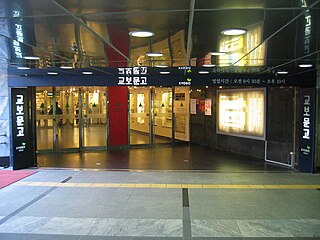
Kyobo Book Centre is the largest bookstore chain in South Korea. It has ten stores in seven cities, with the flagship Main Store, or Gwanghwamun-jeom in Seoul, which is located in the basement of the Kyobo Building, at 1 Jong-ro, Jongno-gu in Seoul's central business district.

GS Group is one of the largest South Korean conglomerates. GS comprises GS Holdings, subsidiaries & affiliates including GS Caltex, GS Retail, GS Shop, GS EPS, GS Global, GS Sports and GS E&C among others. The asset size is 65.4 trillion KRW at the end of 2019 placing GS as the 8th largest chaebol in Korea excluding the public business companies.
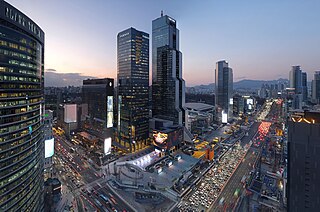
Gangnam District is one of the 25 districts of Seoul, South Korea. The term Gangnam translates to "South of the [Han] River". Gangnam District is the third largest district in Seoul, with an area of 39.5 km2 (15.3 sq mi). As of the 2024 census, Gangnam District had a population of 556,570. There is a high concentration of wealth in the district, with prices for an apartment as of 2024 more than double those in the rest of Seoul. Gangnam District is part of Gangnam School District Eight, along with the Seocho District. This district shares half of Gangnam-daero Gangnam Station area with Seocho District, which is one of the most crowded places in South Korea.
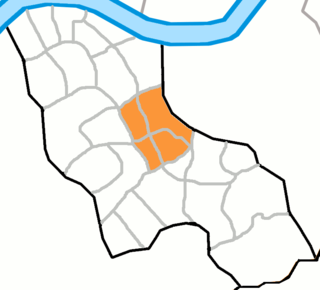
Daechi-dong (대치동) is an affluent neighborhood in Gangnam-gu, Seoul, South Korea. Daechi-dong is divided into three different “dongs” which are Daechi 1-dong, 2-dong, and 4-dong. Daechi-dong is predominantly considered the residential area of Gangnam. As a result, real estate in the area is highly competitive and expensive compared to other parts of Gangnam. The Yangjaecheon is a stream that runs through the heart of Daechi-dong.

Yeongdeungpo District is an administrative district in southwest Seoul, South Korea. Although the origin of the name is uncertain, the first two syllables are thought to be from "yeongdeung" (靈登) or "divine ascent", a shamanic rite. The third syllable is "po", representing the bank of a river (浦), referring to the district's position on the Han River. The 2006 population was 408,819.

Seocho District is one of the 25 local government districts which make up the city of Seoul, South Korea. Seocho is a part of the Gangnam region, along with the Gangnam district of Seoul. Seocho District ranks as one of the richest neighborhoods in South Korea and among the most expensive areas in Seoul with an average sales price of 47.75 million South Korean won per 3.3 square meters. Many of the wealthiest residents are concentrated in the three Gangnam districts including Seocho, known as Gangnam School District Eight.

Cheongdam-dong (Korean: 청담동) is a ward of Gangnam District in Seoul, South Korea. The area is best known in South Korea as an affluent neighborhood populated by a disproportionately high number of high-income individuals and for having some of the most expensive real estate in the country. It is known as an upmarket shopping area, with the main shopping street dubbed Cheongdam Fashion Street. Along with Apgujeong's Rodeo Street in Apgujeong-dong and Garosu-gil in Sinsa-dong, which are connected by the main Apgujeong-ro, they are seen as fashionable and trendsetting destinations.

Yeoksam-dong (Korean: 역삼동) is a ward of Gangnam-gu, Seoul, South Korea. Teheranno runs through Yeoksam-dong and has some of the tallest buildings in Seoul, comprising a collection of corporate headquarters and high-rise office buildings.
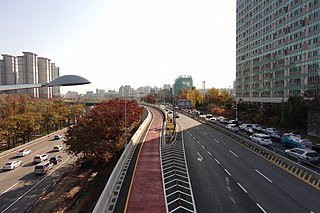
Yeoui-dong (Korean: 여의동) is a dong (neighborhood) of Yeongdeungpo-gu in Seoul, South Korea.
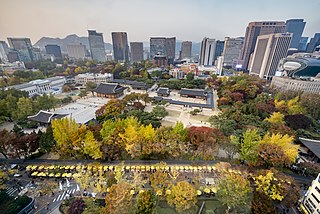
Seoul, officially Seoul Special City, is the capital and largest city of South Korea. The broader Seoul Capital Area, encompassing Gyeonggi province and Incheon metropolitan city, emerged as the world's fourth largest metropolitan economy in 2014, trailing only Tokyo, New York City, and Los Angeles, hosting more than half of South Korea's population. Although Seoul's population peaked at slightly over 10 million, it has gradually decreased since 2014, standing at approximately 9.97 million residents as of 2020. Seoul is the seat of the South Korean government.
Seoul, the capital of South Korea, is home to giant business groups such as Hyundai, SK, LG, Hanhwa, GS, KB, CJ and Samsung, ranking fifth in global city GDP and second in Asian city GDP. The service sector accounts for the largest portion of the city's labor force. As the center of the country's finance, Seoul is concentrated in Yeouido, where the headquarters of major stock exchanges and banks are located. The city holds many annual trade fairs.

The Digital Media City Landmark Building or DMC Landmark Building, also known as Seoul Lite or Light Tower, was a 133-floor, 640 m (2,100 ft) supertall skyscraper proposed for construction in Digital Media City, Seoul, South Korea. It was slated to become the third-tallest building in the world when completed, after Burj Khalifa and Pingan International Finance Centre. It would have been the tallest building in Korea. Construction broke ground on 16 October 2009, and was scheduled to be completed and ready for occupancy by April 2015. It was to be built with the country's own capital and technology at an estimated cost of 3.3 trillion won.

GS25 (Korean: 지에스25) is a South Korean chain of convenience stores operated and owned by GS Retail, a subsidiary company of the GS Group. The headquarters of the company are located at the GS Tower in Gangnam-gu, Seoul. As of June 9, 2020, GS25 operates 13,899 stores.
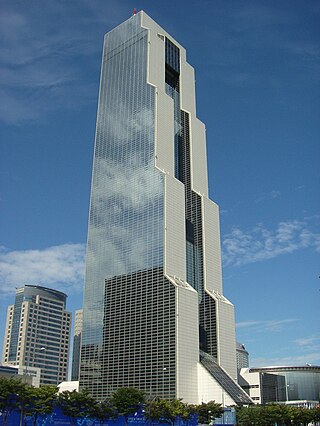
| film. = Independence Day (1996) [2016] {20 Years Ago in Timon Türkiye & Cast & Brazilian Students}

ASEM Tower is an office building located in Samseong-dong, Gangnam district, Seoul. It was constructed for the 3rd Asia–Europe Meeting in 2000.

Parnas Tower is a 38-floor, 183-metre (600 ft) skyscraper in Gangnam-gu, Seoul. It was developed by GS Engineering & Construction in 2016 and was sold to an affiliate, GS Retail.

Gangnam, sometimes referred to as the Greater Gangnam Area, is a geographic and cultural region in Seoul. While Gangnam can refer to the entire region of Seoul south of the Han River, the region is generally defined as consisting of the city's affluent Gangnam, Seocho and Songpa districts. Other definitions define Gangnam by the boundaries of the Gangnam Eighth School District or by the commercial zones around Gangnam Highway, Yangjae Station, Sinsa Station, Nonhyeon Station, Sinnonhyeon Station and Gangnam station. These definitions exclude the Songpa District, which has been argued to be culturally and administratively distinct from the Gangnam and Seocho districts.


















